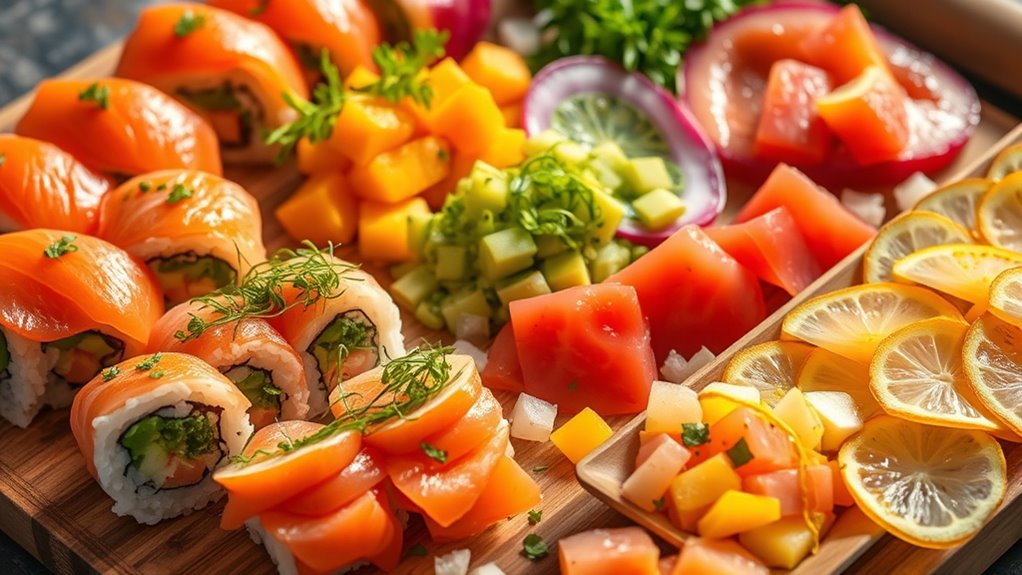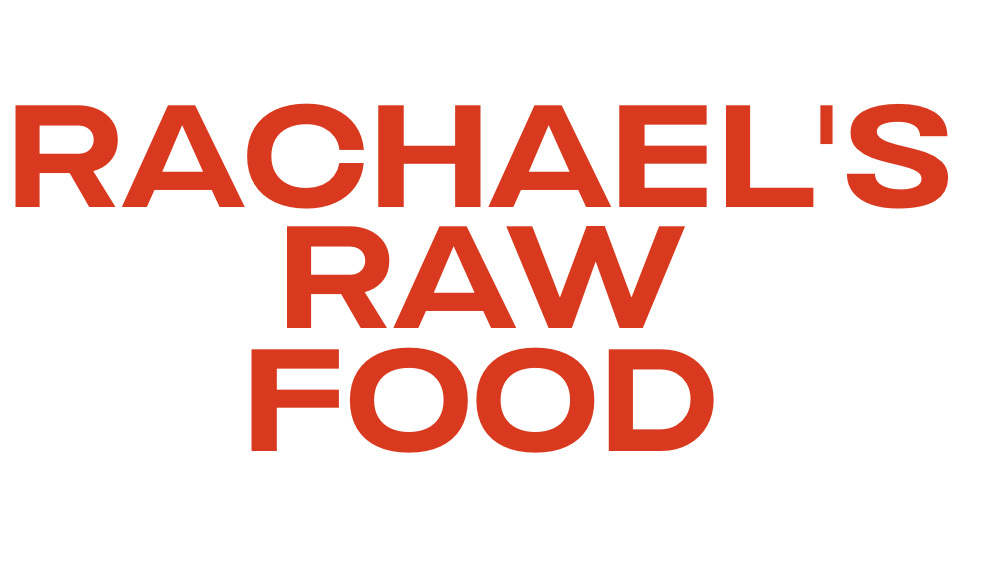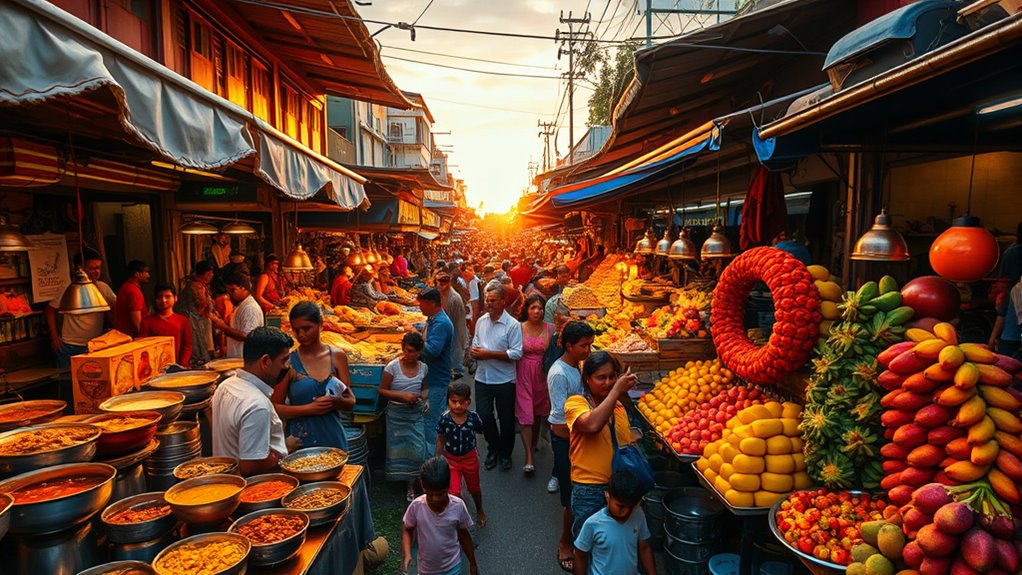Begin a journey through diverse cultures with raw dishes that reflect regional flavors, history, and traditions. From Japanese sashimi’s delicate craftsmanship to Latin American ceviche’s tropical zest, each meal showcases unique ingredients and culinary philosophies. These raw foods highlight freshness, bold spices, or minimalist elegance, revealing how geography influences taste. If you keep exploring, you’ll uncover the fascinating stories behind these vibrant culinary expressions from around the world.
Key Takeaways
- The trip showcases diverse raw dishes reflecting unique cultural traditions, ingredients, and regional flavor profiles worldwide.
- It highlights iconic raw foods like Japanese sashimi, Latin ceviche, and Scandinavian cured fish, emphasizing craftsmanship and freshness.
- Culinary styles vary from bold, spicy Indian-inspired preparations to minimalist Mediterranean raw bites.
- The journey demonstrates how cultural history and geography influence raw food ingredients and presentation.
- It celebrates global culinary diversity through the universal language of fresh, uncooked ingredients.

Begin a culinary journey without leaving your kitchen by exploring “Around the World in 80 Raw Meals.” This adventurous guide takes you through diverse cultures and flavors, all served raw, fresh, and vibrant. As you explore into these dishes, you’ll notice how cultural influences shape the ingredients and presentation, creating a tapestry of global culinary artistry. Each raw meal reflects the unique history, geography, and traditions of its origin, offering you a taste of the world’s rich diversity without any cooking involved.
Embark on a global raw food adventure, exploring diverse flavors and cultural stories without cooking.
In many cultures, raw foods are deeply rooted in history and ritual. For example, Japanese sashimi highlights the precision and elegance of Japanese culinary influences, emphasizing delicate cuts of fresh fish that showcase the natural flavor profiles. Meanwhile, ceviche from Latin America combines citrus and chili to create a tangy, spicy profile that speaks to coastal traditions and tropical climates. These cultural influences don’t just dictate ingredients; they influence the entire flavor profile, balancing acidity, heat, umami, and freshness in ways that are both familiar and surprising.
You’ll also discover how regional ingredients define flavor profiles. In Southeast Asia, raw dishes often incorporate herbs like cilantro, mint, and basil, adding aromatic complexity and a punch of freshness. In contrast, Scandinavian raw meals might focus on subtlety, using lightly cured fish paired with dill and rye for a delicate, understated flavor. The diversity of flavor profiles across raw dishes underscores the importance of local ingredients and culinary philosophies, inviting you to appreciate how geography and culture impact taste.
As you sample these raw creations, you’ll notice that each dish is crafted to highlight the natural flavors of its ingredients. The emphasis on freshness is universal, but the way flavors are balanced varies widely. Some meals lean toward bold, spicy, and vibrant profiles, while others are light, clean, and subtly nuanced. This variety reflects the cultural influences that shape these dishes, from the fiery heat of Indian-inspired raw preparations to the minimalist elegance of Mediterranean raw foods.
Frequently Asked Questions
How Does the Author Maintain Food Safety During Raw Meal Preparation?
You can uphold food safety during raw meal preparation by following strict hygiene practices, like washing your hands thoroughly and sanitizing surfaces. To prevent food contamination, always use fresh ingredients and keep raw foods separate from cooked ones. Proper storage at appropriate temperatures is essential. Staying vigilant about cleanliness and handling raw ingredients carefully helps ensure safety, reducing the risk of foodborne illnesses during your raw meal prep.
What Equipment Is Essential for Preparing Raw Dishes on the Go?
When preparing raw dishes on the go, you need essential equipment like portable blenders and travel knives. Portable blenders let you quickly blend smoothies or dressings without mess, while travel knives help you chop fruits and vegetables safely. These tools are compact, lightweight, and easy to clean, making them perfect for maintaining food prep efficiency and safety during your travels. Always guarantee your equipment is clean to avoid contamination.
How Does Raw Eating Influence Local Food Cultures and Traditions?
Imagine a time traveler bringing raw eating into the present—your choices can impact local food cultures and traditions. By embracing raw dishes, you promote cultural preservation through authentic recipes while inspiring culinary innovation. This approach respects heritage, yet encourages modern twists, blending old and new. Your raw food journey enriches local cuisine, fostering appreciation and diversity, and ensuring these traditions thrive amidst global change.
Are There Any Health Risks Associated With Consuming Raw Meals Worldwide?
You should be aware that consuming raw meals can pose health risks like foodborne illnesses if proper hygiene isn’t maintained. Pesticide concerns also come into play, especially with raw produce, which may carry residues. Always wash ingredients thoroughly and source from trusted suppliers. While raw eating offers many benefits, staying cautious helps you enjoy it safely, reducing risks associated with bacteria or pesticides.
How Does the Author Adapt Recipes to Available Ingredients in Different Countries?
You notice the author seamlessly adapts recipes by embracing ingredient substitution, turning local produce into culinary treasures. This coincidence of available ingredients sparks creative flavor adaptation, ensuring each dish remains authentic yet unique. You realize that by flexing recipes, the author connects cultures through shared tastes, making each raw meal a reflection of its environment. This approach transforms challenges into opportunities for innovation and cultural appreciation.
Conclusion
As you’ve seen, exploring global cuisine through raw meals offers a fresh perspective on cultural diversity. Did you know that the raw food movement has grown by over 300% in the last decade? By trying these dishes, you’re not only nourishing your body but also connecting with traditions around the world. So, next time you plan a trip, consider adding raw meals to your itinerary—there’s a whole world of flavors waiting to be discovered!










